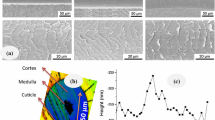Abstract
α-keratin is a hydrogen-bond dominated composite material. The dry α-keratin (0% regain) of the horns of an oryx has a stiffness of 6.1 GPa. Water interacts only with the amorphous matrix of α-keratin to break down structural hydrogen bonds and reduce stiffness to 4.3 GPa at 20% regain and 1.8 G Pa at 40% regain. The effect of water on the stiffness of horn α-keratin is not modelled by the Voigt estimate at high to moderate regains. Water interacts probably with the disordered regions within the fibres which reduces the effective fibre length. As a result the reinforcing effect of the fibres is reduced and the stiffness and strength of hydrated horn keratin are less than that predicted by the simple Voigt estimate. If the Voigt estimate is modified to take into account a short fibre length of 40 nm, the stiffness and tensile strength of horn α-keratin can be modelled successfully.
Similar content being viewed by others
References
B. Harris, in Proceedings of Symposium of the Society for Experimental Biology No. 34, Leeds University, September 1979, edited by J. F. V. Vincent and J. D. Currey (Cambridge University Press, Cambridge, 1980) p. 37.
R. F. Ker, DPhil thesis, University of Oxford (1977).
A. Kelly, “Strong solids” (Oxford University Press, Oxford, 1973).
R. D. B. Fraser andT. P. Macrae, in Proceedings of Symposium of the Society for Experimental Biology No. 34, Leeds University, September 1979, edited by J. F. V. Vincent and J. D. Currey (Cambridge University Press, Cambridge, 1980) p. 211.
R. E. Dickerson andI. Geis. “The structure and action of proteins” (W. A. Benjamin, Menlo Park, California, 1969).
A. H. Nissan,Macromolecules 9 (1976) 540.
M. Druhala andM. Feughelman,Colloid Polym. Sci. 252 (1974) 381.
J. B. Speakman,J. Soc. Chem. Ind. 49 (1930) 209.
I. C. Watt andJ. D. Leeder,Trans. Faraday Soc. 60 (1964) 1335.
S. Rosenbaum,J. Polym. Sci. C 31 (1970) 45.
G. King,Trans. Faraday Soc. 41 (1945) 479.
R. D. B. Fraser, T. P. Macrae andG. E. Rogers. “Keratins: their composition, structure and biosynthesis” (Thomas, Springfield, Illinois, 1972).
R. C. Stephens, “Strength of materials” (Arnold, London, 1970).
R. J. Roark andW. C. Young, “Formulas for stress and strain”, 5th Edn (McGraw-Hill, London, 1975).
F. L. Warburton,J. Text. Inst. 39 (1948) 297.
A. C. Kitchener, PhD thesis, University of Reading (1985).
S. A. Wainwright, W. D. Biggs, J. D. Currey andJ. M. Gosline, “Mechanical design in organisms” (Arnold, London, 1976).
M. Feughelman,J. Macromol. Sci.-Phys. B 16 (1979) 155.
G. E. Rogers,Ann. N.Y. Acad. Sci. 83 (1959) 378.
Author information
Authors and Affiliations
Rights and permissions
About this article
Cite this article
Kitchener, A., Vincent, J.F.V. Composite theory and the effect of water on the stiffness of horn keratin. J Mater Sci 22, 1385–1389 (1987). https://doi.org/10.1007/BF01233138
Received:
Accepted:
Issue Date:
DOI: https://doi.org/10.1007/BF01233138




